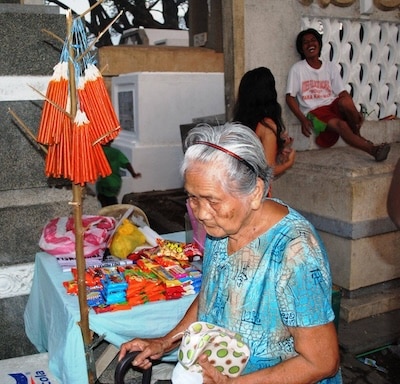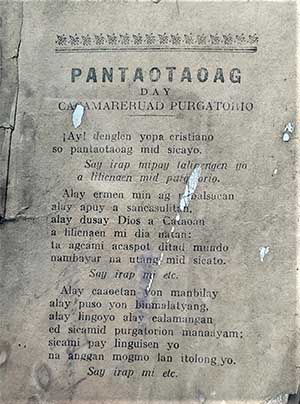
Pistay Inatey
 By Rex Catubig
By Rex Catubig
WHEN I see Nanang, our old-maid aunt, in the kitchen, stirring black gooey Deremen in a deep kawali perched on the wood-fired clay dalikan, I know it’s Pistay Inatey—All Saint’s Day, the highlight of Ani or harvest month—when religion and folk custom meld into one celebration.
Following the belief that the spirits of the dead gain heavenly pass and wander the earth to visit their loved ones, however momentarily, we pause to remember and welcome them in our midst.
So we prepare food– the beloved viscous Inlubi—burnt rice or Deremen cooked in coconut cream until reduced or Ingata, like thick porridge, mixed with slices of Togui—its root crop eternal partner.

And we light candles. Prior to the garden cemeteries with underground graves, the cemeteries abound with above ground rectangular vaults, singly or piled on top of one another, that we lit with candles. At twilight, their flickering light envelops the cemetery with a surreal glow, their wafting smoke spiraling up to the heavens, filling the place with their unmistakable wax scent.
Before dripless candles, we delight in collecting the drippings that cascade on the side and bottom of the candles, fashioning them into handcrafted balls, competing who makes the biggest.
It goes without saying, the reception is never complete without Flores para los Muertos. We do not buy them from the florists, there is none in the barrio. We buy them in the public market, though they are grown in every yard. My sister and my aunt fashion them as bouquets in crystal vases or as wreath, using banana stems as the base in which the flowers are stuck.

They are the basic Pistay Inatey blooms: no fancy orchids or stargazers or gladiolas, or anthuriums. Instead, we have the garden variety Botinggang or Globe amaranth, Palong-palong—so-called because it resembles a cockscomb, and golden Marigolds whose pungent scent stands out in my memory.
Being at the cemetery even part of the day is a spartan challenge of faith. I don’t remember having a picnic in the hallowed grounds, nor is there music like now. Aside from Sacristan bells, the only sound heard is the singing by the roving quasi-religious minstrels called Cantores, who for a fee, sing heavenly hymns for your dead.
As it gets dark, the burnt charcoal Inlubi would be waiting at home. But not only the living feast on the seasonal delicacy. It’s a time-honored custom in our barrio Calmay to offer food and libation to the dear departed as a form of obeisance and to appease restive spirits who dwell in the place. It’s called Pabtang and consists of small servings of food, drinks, and a lighted votive candle.

Usually, the deceased is served his favorite food and drinks.
Having fulfilled its Pistay Inatey obligations, exhausted from the foray into the realm of the dead, the household sleeps early. But only to be awakened by the Mantawtawag—a group of elders who personify the wandering souls of purgatory who sing plaintively of their tribulation, imploring the living to hear their story:
“Ay denglen yo pa Cristiano so pantaotaoag mid sikayo.
Say irap mi pay talingen yo, a liliknaen mid Purgatoryo”
And it doesn’t end there. In the dead of the night, the family is roused from sleep by the squawking of free range fowls. The village pranksters in a traditional custom called Pankamarerwa, or foraging by soul spoofers, take advantage of the customary license to engage in petty theft, victimizing unaware neighbors by stealing their chickens or roosters cooped below their nipa huts.
It’s the precursor of the western trick or treat.
These gamut of folk rites and rituals happen only overnight. Before the cock crows for the third time, as the sun peeps on the horizon beyond the fishponds, Pistay Inatey is over, the spirits of the dead are presumed to be back in heaven or the nether world, to await another homecoming.
Meantime life goes on. And amid regular chore, the thought of Misa de Gallo plays on the mind.










